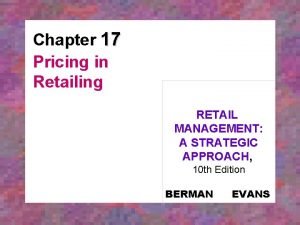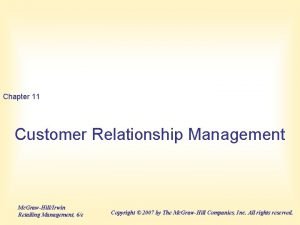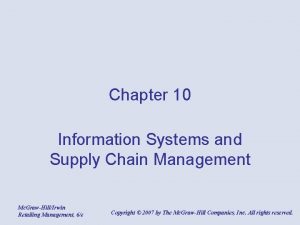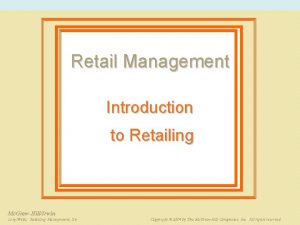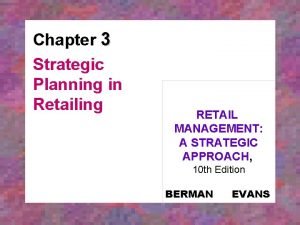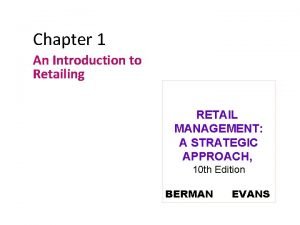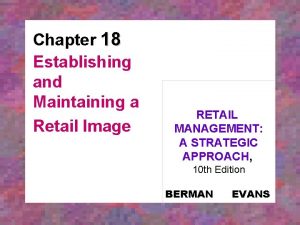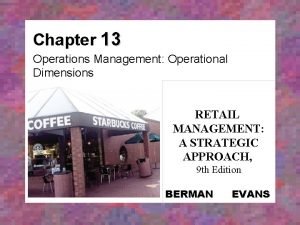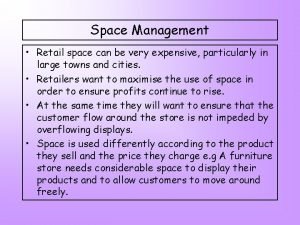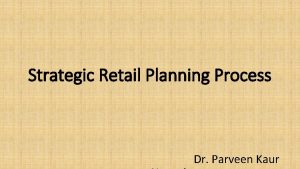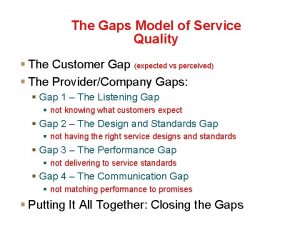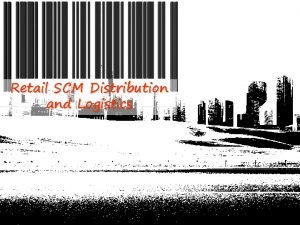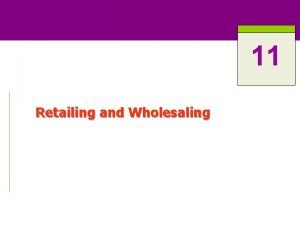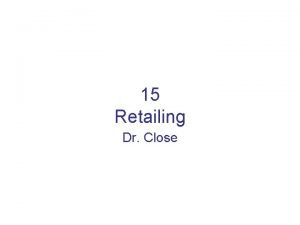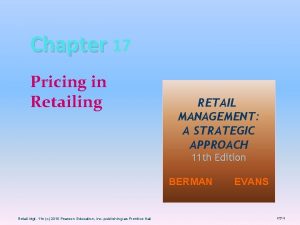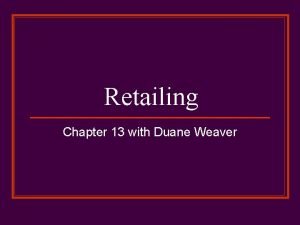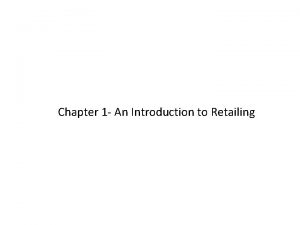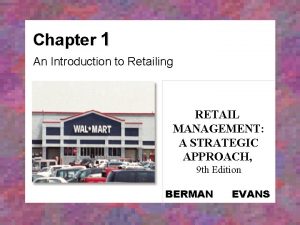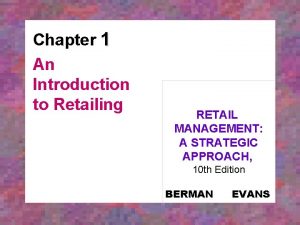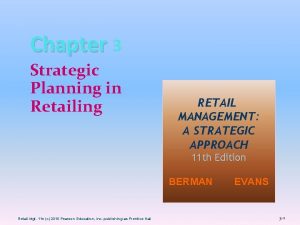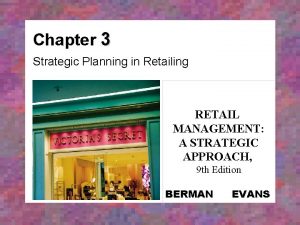Chapter 17 Pricing in Retailing RETAIL MANAGEMENT A






























- Slides: 30

Chapter 17 Pricing in Retailing RETAIL MANAGEMENT: A STRATEGIC APPROACH, 9 th Edition BERMAN EVANS

Chapter Objectives ¯ To describe the role of pricing in a retail strategy and to show that pricing decisions must be made in an integrated and adaptive manner ¯ To examine the impact of consumers; government; manufacturers, wholesalers, and other suppliers; and current and potential competitors on pricing decisions ¯ To present a framework for developing a retail price strategy: objectives, broad policy, basic strategy, implementation, and adjustments 17 -2

Pricing Options for Retailers ¯ Discount orientation ¯ At-the-market orientation ¯ Upscale orientation 17 -3

Figure 17. 1 Ross Dress for Less Means Value 17 -4

Figure 17. 2 Factors Affecting Retail Price Strategy 17 -5

Price Elasticity of Demand ¯ The sensitivity of customers to price changes in terms of the quantities they will buy * Elastic – small percentage changes in price lead to substantial percentage changes in the number of units bought * Inelastic – large percentage changes in price lead to small percentage changes in the number of units bought 17 -6

Table 17. 1 A Movie Theater’s Elasticity of Demand Price ($) 6. 00 Tickets Sold (Saturday Night) 1, 000 Total Ticket Receipts Elasticity of Demand (E) 6, 000 E = 0. 68 7. 00 900 6, 300 E = 0. 79 8. 00 810 6, 480 E = 1. 00 9. 00 720 6, 480 E = 2. 54 10. 00 17 -7 550 5, 500

Price Sensitivity Market Segments ¯ Economic consumers ¯ Status-oriented consumers ¯ Assortment-oriented consumers ¯ Personalizing consumers ¯ Convenience-oriented consumers 17 -8

The Government and Retail Pricing ¯ Horizontal Price Fixing ¯ Vertical Pricing Fixing ¯ Price Discrimination (Robinson-Patman Act) ¯ Minimum Price Laws ¯ Unit Pricing ¯ Item Price Removal ¯ Price Advertising 17 -9

Justifiable Price Discrimination ¯ Products are physically different ¯ The retailers paying different prices are not competitors ¯ Competition is not injured ¯ Price differences are due to differences in supplier costs ¯ Market conditions change – costs rise or fall or competing suppliers shift their prices 17 -10

Competition and Retail Pricing ¯ Market pricing – retailers often price similarly to each other and have less control over price because consumers can easily shop around ¯ Administered pricing – firms seek to attract consumers on the basis of distinctive retailing mixes 17 -11

Figure 17. 3 A Framework for Developing a Retail Price Strategy 17 -12

Objectives and Pricing Market Skimming Market Penetration 17 -13

Figure 17. 4 A Marketing Skimming Approach 17 -14

Figure 17. 5 Specific Pricing Objectives from Which Retailers May Choose 17 -15

Price Policy Choices ¯ No competitors will have lower prices; no competitors will have higher prices; or prices will be consistent with competitors ¯ All items will be priced independently or the prices for all items will be interrelated to maintain image and ensure proper markups ¯ Price leadership will be exerted; competitors will be price leaders and set prices first; or prices will be set independently of competitors ¯ Prices will be constant over a year or season; or prices will change if costs change 17 -16

Price Strategy ¯ Demand-Oriented Pricing ¯ Cost-Oriented Pricing ¯ Competition-Oriented Pricing 17 -17

Demand-Oriented Pricing ¯ Psychological pricing * Price-quality association * Prestige pricing 17 -18

Table 17. 4 Markup Equivalents Percentage of Retail 17 -19 Percentage of Cost 10. 0 11. 1 20. 0 25. 0 30. 0 42. 9 40. 0 66. 7 50. 0 100. 0 60. 0 150. 0 70. 0 233. 3 80. 0 400. 0 900. 0

Figure 17. 6 How to Determine Direct Product Profitability 17 -20

Integration of Approaches to Price Strategy ¯ If prices are reduced, will revenues increase greatly? (Demand orientation) ¯ Should different prices be charged for a product based on negotiations with customers, seasonality, and so on? (Demand orientation) ¯ Will a given price level allow a traditional markup to be attained? (Cost orientation) ¯ What price level is necessary for a product requiring special costs in purchasing, selling, or delivery? (Cost orientation) ¯ What price levels are competitors setting? (Competitive orientation) ¯ Can above-market prices be set due to a superior image? (Competitive orientation) 17 -21

Figure 17. 7 A Checklist of Selected Specific Pricing Decisions 17 -22

Price Strategy Concepts ¯ Customary Pricing * Everyday Low Pricing ¯ Variable Pricing * Yield Management Pricing ¯ One-Price Policy 17 -23 ¯ Flexible Pricing * Contingency Pricing ¯ Odd Pricing ¯ Leader Pricing ¯ Multiple-Unit Pricing ¯ Price Lining

Figure 17. 8 Ikea and Low Pricing 17 -24

Figure 17. 9 Odd Pricing: A Popular Retailing Tactic 17 -25

Reasons to Use Multiple-Unit Pricing ¯ A firm could seek to have shoppers increase their total purchases of an item ¯ This approach can help sell slow-moving and end-of-season merchandise ¯ Price bundling may increase sales of related items 17 -26

Price Adjustments ¯ Adaptive mechanism * Markdown * Additional markup * Employee discount 17 -27

Figure 17. 10 A Price Change Authorization Form 17 -28

Timing Markdowns ¯ Early markdown policy ¯ Late markdown policy ¯ Staggered markdown policy ¯ Automatic markdown plan ¯ Storewide clearance 17 -29

Figure 17. 11 Promoting Markdowns 17 -30
 Retail communication mix elements
Retail communication mix elements Retail organization
Retail organization Pricing in retailing
Pricing in retailing Price adjustment in retail management
Price adjustment in retail management Retail management chapter 1 ppt
Retail management chapter 1 ppt Strategic profit model
Strategic profit model Crm process in retailing
Crm process in retailing Crm in marketing ppt
Crm in marketing ppt Information system and supply chain management in retailing
Information system and supply chain management in retailing Introduction to retail management
Introduction to retail management It is the overall plan of action that guides a retailer.
It is the overall plan of action that guides a retailer. Chapter 13 retailing and wholesaling
Chapter 13 retailing and wholesaling Introduction to retail business
Introduction to retail business Retail financial mgt
Retail financial mgt Retail information system
Retail information system Trade area analysis in retail management
Trade area analysis in retail management Gap model in retail management
Gap model in retail management Concept of retail management
Concept of retail management Layout strategies examples
Layout strategies examples Process layout in operations management
Process layout in operations management Strategic planning in retailing
Strategic planning in retailing Retail service layout
Retail service layout Retail image management
Retail image management Retail management and operations
Retail management and operations Trading area analysis ppt
Trading area analysis ppt What is space management in retail
What is space management in retail Retail planning process
Retail planning process Layout strategies examples
Layout strategies examples Benefits of business intelligence in the retail sector
Benefits of business intelligence in the retail sector Service gaps
Service gaps Retail and distribution chains
Retail and distribution chains


